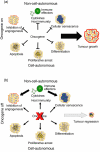Immunology in the clinic review series; focus on cancer: multiple roles for the immune system in oncogene addiction
- PMID: 22235994
- PMCID: PMC3278684
- DOI: 10.1111/j.1365-2249.2011.04514.x
Immunology in the clinic review series; focus on cancer: multiple roles for the immune system in oncogene addiction
Abstract
Despite complex genomic and epigenetic abnormalities, many cancers are irrevocably dependent on an initiating oncogenic lesion whose restoration to a normal physiological activation can elicit a dramatic and sudden reversal of their neoplastic properties. This phenomenon of the reversal of tumorigenesis has been described as oncogene addiction. Oncogene addiction had been thought to occur largely through tumour cell-autonomous mechanisms such as proliferative arrest, apoptosis, differentiation and cellular senescence. However, the immune system plays an integral role in almost every aspect of tumorigenesis, including tumour initiation, prevention and progression as well as the response to therapeutics. Here we highlight more recent evidence suggesting that oncogene addiction may be integrally dependent upon host immune-mediated mechanisms, including specific immune effectors and cytokines that regulate tumour cell senescence and tumour-associated angiogenesis. Hence, the host immune system is essential to oncogene addiction.
© 2012 The Authors. Clinical and Experimental Immunology © 2012 British Society for Immunology.
Figures


References
-
- Felsher DW. Cancer revoked: oncogenes as therapeutic targets. Nat Rev Cancer. 2003;3:375–80. - PubMed
-
- Weinstein IB, Joe A. Oncogene addiction. Cancer Res. 2008;68:3077–80. discussion 80. - PubMed
-
- Sharma SV, Settleman J. Oncogene addiction: setting the stage for molecularly targeted cancer therapy. Genes Dev. 2007;21:3214–31. - PubMed
-
- Felsher DW, Bishop JM. Reversible tumorigenesis by MYC in hematopoietic lineages. Mol Cell. 1999;4:199–207. - PubMed
-
- Jain M, Arvanitis C, Chu K, et al. Sustained loss of a neoplastic phenotype by brief inactivation of MYC. Science. 2002;297:102–4. - PubMed
Publication types
MeSH terms
Substances
Grants and funding
LinkOut - more resources
Full Text Sources

